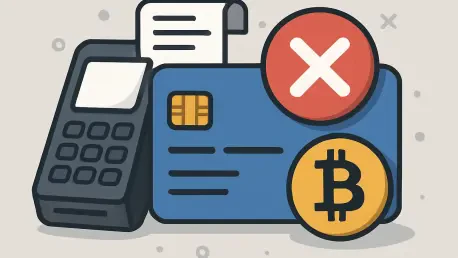As the world of cryptocurrency continues to evolve, few voices carry as much weight as Priya Jaiswal, a distinguished expert in Banking, Business, and Finance. With a deep background in market analysis, portfolio management, and international business trends, Priya offers unparalleled insights into the shifting landscape of digital assets. In this interview, we dive into the surprising decline of cryptocurrency as a payment method in the U.S., explore the factors driving this trend, and discuss the potential impact of recent regulatory developments like the Genius Act. From consumer hesitancy to merchant influence, Priya unpacks the complexities of crypto adoption and what it means for the future of payments.
Can you walk us through the key findings from the recent Kansas City Fed survey regarding cryptocurrency use for payments in the U.S.?
Absolutely. The Kansas City Fed survey revealed a notable decline in the use of cryptocurrency for payments over the past few years. In 2024, only 1.9% of U.S. consumers used crypto to pay for something, which is down from 2.6% in 2021 and 2.7% in 2022. While there was a slight uptick from 1.7% in 2023, the overall trend points to a shrinking user base. This suggests that despite the buzz around digital currencies, they’re not gaining traction as a practical payment tool for most Americans.
What do you think is behind this persistent drop in cryptocurrency usage for payments since 2021?
I believe several factors are at play. First, there’s a lack of widespread infrastructure—many merchants still don’t accept crypto, and even when they do, the process can be clunky. Second, volatility remains a huge barrier; most consumers don’t want to deal with the risk of value fluctuations when making everyday purchases. Lastly, awareness and education are still limited. A lot of people either don’t understand how to use crypto for payments or don’t see a compelling reason to switch from traditional methods like credit cards or digital wallets, which are faster and more familiar.
Given that only 1.9% of consumers used crypto for payments in 2024, how do you interpret such a low adoption rate despite all the hype around digital currencies?
Honestly, it’s not entirely surprising. The hype around crypto often centers on investment potential or speculative gains rather than its utility as a payment method. That 1.9% reflects a niche group, likely early adopters or those in specific ecosystems where crypto is more accepted. For the average consumer, though, the practical benefits aren’t clear enough to outweigh the complexities. It also points to a trust gap—whether it’s skepticism about security or just not seeing crypto as a reliable alternative to cash or cards.
The survey noted that merchants or payees seem to be driving the limited use of crypto more than consumers. Why do you think that’s happening?
Merchants pushing crypto payments often see it as a way to differentiate themselves or tap into a tech-savvy customer base. Some may also be looking to avoid high transaction fees associated with traditional payment processors. In certain industries, like online gaming or cross-border transactions, crypto can offer advantages like faster settlements or access to global markets. I suspect many consumers are simply accommodating these requests rather than actively seeking out crypto as their preferred payment method.
Speaking of payee influence, the survey showed that 35.4% of crypto users in 2024 used it because the person they were paying requested it, up from 21.2% in 2022. What’s driving this shift?
This jump likely reflects growing comfort among certain businesses or individuals with crypto as a payment option, especially in niche sectors. For example, freelancers or small businesses operating internationally might prefer crypto to avoid currency conversion fees or delays with traditional banking. It’s also possible that as more tools and platforms make crypto transactions easier, payees feel more confident requesting it. I think this trend could continue in specific contexts, though it’s unlikely to become mainstream without broader consumer buy-in.
The survey also found that only 17.7% of users cited speed and just 3.1% mentioned distrust in banks as reasons for using crypto. What do these low figures tell us about the motivations of crypto users?
These numbers challenge the common narrative that speed and distrust in the financial system are the primary drivers for crypto adoption. Instead, it seems other factors—like payee preference, as we discussed, or even curiosity and experimentation—are more influential for the small group using crypto for payments. It suggests that the practical advantages of crypto aren’t resonating with most users, or perhaps the alternatives, like digital wallets, are already meeting needs for speed and convenience more effectively.
With the Genius Act signed into law in July to provide a regulatory framework for stablecoins, how do you see this impacting the future of crypto payments?
The Genius Act is a step toward legitimacy for stablecoins, which are designed to be less volatile and more suitable for payments compared to other cryptocurrencies. By setting up some regulatory guardrails, it could encourage more merchants and consumers to experiment with stablecoins, knowing there’s a clearer legal framework. However, regulation alone won’t solve the underlying issues of usability and trust. It’s a positive move, but I’m cautious about expecting a dramatic uptick in adoption without parallel improvements in infrastructure and public perception.
Looking ahead, what is your forecast for the role of cryptocurrency in everyday payments over the next few years?
I think cryptocurrency will remain a niche payment method in the near term, primarily used in specific industries or for particular use cases like cross-border transactions. Stablecoins have the most potential to carve out a space due to their relative stability, especially with new regulations providing clarity. However, for crypto to become a mainstream payment option, we’ll need to see significant advancements in user-friendliness, merchant acceptance, and public trust. Without those, it’s likely to stay on the fringes of the payment landscape for most consumers.









